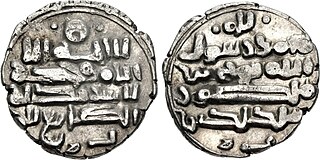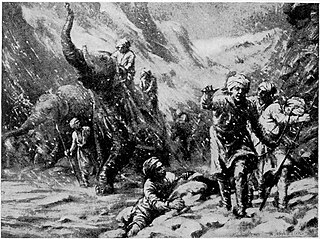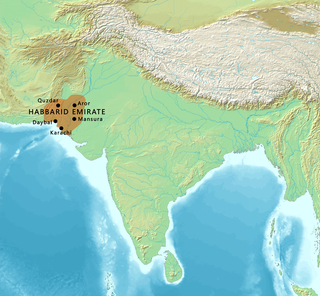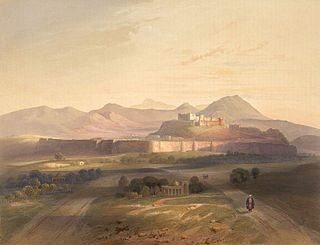
The Muslim conquests of Afghanistan began during the Muslim conquest of Persia as the Arab Muslims migrated eastwards to Khorasan, Sistan and Transoxiana. Fifteen years after the battle of Nahāvand in 642 AD, they controlled all Sasanian domains except in Afghanistan. Fuller Islamization was not achieved until the period between 10th and 12th centuries under Ghaznavid and Ghurid dynasties who patronized Muslim religious institutions.

Multan is a city in Punjab, Pakistan, located on the bank of river Chenab. It is one of the five largest urban centres of Pakistan in 2024 and serves as the administrative centre of Multan Division. A major cultural, religious and economic centre of Punjab region, Multan is one of the oldest inhabited cities of Asia, with a history stretching deep into antiquity.

Laghman is one of the 34 provinces of Afghanistan, located in the eastern part of the country. It has a population of about 502,148, which is multi-ethnic and mostly a rural society. Laghman hosts a large number of historical landmarks, minarets, monuments, and other cultural relics that are manifestation of its old history and culture. The city of Mihtarlam serves as the capital of the province. In some historical texts the name is written as "Lamghan" or as "Lamghanat".

Abu Mansur Nasir ad-Din wa'd-Dawla Sabuktigin was the founder of the Ghaznavid dynasty, and amir of Ghazna from 977 to 997. Sabuktigin was a Turkic slave who was bought by Alp-Tegin, the commander of the royal guard of the Samanid dynasty. Alp-Tegin established himself as the governor of Ghazna in 962, and died a year later in 963. Afterwards, Sabuktigin built his prestige among other slave soldiers in Ghazna until he was elected by them as their ruler in 977.

Abu al-Qasim Mahmud ibn Sabuktigin, usually known as Mahmud of Ghazni or Mahmud Ghaznavi, was Sultan of the Ghaznavid Empire, ruling from 998 to 1030. During his reign and in medieval sources, he is usually known by his honorific Yamin al-Dawla. At the time of his death, his kingdom had been transformed into an extensive military empire, which extended from northwestern Iran proper to the Punjab in the Indian subcontinent, Khwarazm in Transoxiana, and Makran.

Jayapala was a ruler of the Hindu Shahi dynasty from 964 to 1001 CE. He ruled over the area which stretched from Laghman in the west, to Kashmir in the east and from Sirhind to Multan. He was the son of Hutpal and the father of Anandapala. Epithets from the Bari Kot inscriptions record his full title as "Parama Bhattaraka Maharajadhiraja Sri Jayapaladeva".
Abu Ali Lawik of the Lawik dynasty was the son of Abu Bakr Lawik, and also a brother-in-law of the Hindu Shahi ruler of the region, Kabul Shah. He was invited by the people of Ghazni to overthrow Böritigin or Pirai and proceeded in alliance with the Shahi Rulers of the region in this venture.
'Yamini Turks had claimed their descent from Shahyar, the last of the Parthian ruler who was killed in 637AD in the battle of Cadesia. The family had migrated to Turkistan and after three generations had passed on as Turks. Their founder Sabuktgin had come into the service of Alptgin, a Samanid governor of Turkistan. The latter had captured Ghazni and settled there in 963AD. He raised Sabuktigin to the position of a general. After the death of Alptgin in 966 AD, Balktgin the commander of Turkish troops succeeded him who was later succeeded by Pirai a slave. The latter was a cruel king and the people of Zabul invited Abu Ali Lawik son of the last ruler of Zabul who in alliance with the Shahis of Udabhanda marched to recover Ghazni. On the way at Charkh, Sabuktgin defeated them and became a hero.
Multan, the 4th largest city of Pakistan, in Punjab province is one of the oldest cities in South Asia, though its exact age has yet to be determined. Multan remained the capital and largest city of Punjab region in late ancient and most of the medieval era. The Multan region was centre of many civilizations throughout its history, and has witnessed warfare across millennia because of its location on a major invasion route between South and Central Asia. Multan reached the height of its splendour during the Arab rule of 9th and 10th century when it was made a separate state, the Emirate of Multan, as it controlled large parts of Punjab and Kashmir. It is famous for its Sufi shrines. Multan province was one of the largest and first-established provinces of the Mughal Empire.
Sultanate of Makran was a medieval Islamic kingdom ruled by the Ma'danid dynasty. It ruled Makran from the late 9th or early 10th century until around the 11th century.

The Habbari were an Arab dynasty that ruled much of Greater Sindh, as a semi-independent emirate from 854 to 1024. Beginning with the rule of 'Umar bin Abdul Aziz al-Habbari in 854 CE, the region became semi-independent from the Abbasid Caliphate in 861, while continuing to nominally pledge allegiance to the Abbasid Caliph in Baghdad. The Habbari ascension marked the end of a period of direct rule of Sindh by the Umayyad and Abbasid Caliphates, which had begun in 711 CE.
Abul Fateh Daud was a ruler from the Lodi dynasty of Multan who ruled the Emirate of Multan. He was deposed by Mahmud of Ghazni, who also massacred the Ismailis in the course of his conquest of Multan.
The Hindu Shahis also referred to as the Uḍi Śāhis were a dynasty established between 843 CE and 1026 CE. They endured multiple waves of conquests for nearly two centuries and its core territory was described as having contained the regions of Eastern Afghanistan and Gandhara, encompassing the area up to the Sutlej river in modern day Punjab, expanding into the Kangra Valley. The empire was founded by Kallar in c. 843 CE after overthrowing Lagaturman, the last Turk Shahi king.
Sheikh Hamid Lodi was the founder of the Lodi dynasty of Multan. He ruled the Emirate of Multan from 985 to 997.

The Lawīk dynasty was the last native dynasty which ruled Ghazni prior to the Ghaznavid conquest in the present-day Afghanistan. Lawiks were originally Hindus, but later became Muslims. They were closely related to the Hindu Shahis, and after 877, ruled under the Hindu Shahi suzerainty.

Emirate of Multan was a medieval Muslim emirate in Punjab that was centred around city of Multan, present-day part of Punjab, Pakistan. It was initially ruled by the tribe of Banu Munabbih. In 959 CE, Ismaili Qarmatians under Banu Lawi gained control of the Emirate and in 1010, it was conquered by Ghaznavid Empire.

The Second Battle of Laghman was fought between the Ghaznavid forces under Sabuktigin and the Hindu Shahi under Jayapala near Laghman in 991 AD. It took place near Laghman, present day Afghanistan.

The First Battle of Laghman was fought near Laghman in present-day Afghanistan, between the Ghaznavid empire under Sabuktigin and the Hindu Shahis under Jayapala in 988 CE. The Ghaznavids defeated the Hindu Shahis and Jayapala signed a treaty in which the Hindu Shahis paid tribute to Ghaznavids.

The Ghaznavid campaigns in India refer to a series of military expeditions lasting 54 years (973–1027) launched by the Ghaznavid Empire, a prominent empire of the 10th and 11th centuries, into the Indian subcontinent, led primarily by Sultan Mahmud of Ghazni, leaving a profound impact on the region's history and culture.

The Ghaznavid invasion of Kannauj or the siege of Kannauj in 1018 was a military campaign conducted by Mahmud of Ghazni, the then ruler of the Ghaznavid Empire, against the Gurjara-Pratihara dynasty. During this siege, the Gurjar ruler, Rajyapala, eventually surrendered to Mahmud of Ghazni, thereby accepting nominal suzerainty under his rule. This event marked the decline of the Gurjara dynasty's power. In the aftermath of his surrender to Mahmud, Rajyapala met his demise at the hands of the Chandela ruler, Vidhyadara, for capitulating to the Ghaznavid conqueror.










